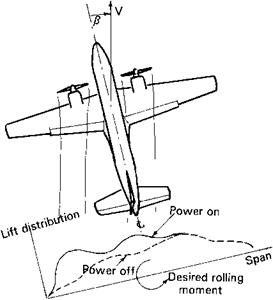Propeller Slipstream Effects
Of all the propeller or jet power effects on stability and control, those due to the propeller slipstream or wake are the most difficult to deal with, analytically or in test. The British engineer William Froude (1810-1879) laid some initial groundwork in his application of momentum theory to establish propeller (or ship screw) slipstream velocity. But the nominally cylindrical slipstream is distorted badly as it passes over wings and fuselages. As a result, slipstream effects on wings, tails, and fuselages are difficult to predict. The Smelt and Davies (1937) and Millikan (1940) papers are fair starts on prediction, but most designers still rely on educated guesses, based on test data from earlier projects.
A few generalities exist for propeller slipstream effects on static longitudinal stability. The relative increment in slipstream velocity over that of the free stream increases as airspeed is reduced, at fixed throttle setting. If the horizontal tail carries a net down load and is exposed to the slipstream, relative higher velocities as airspeed is reduced increases that down load, pitching the airplane nose up, a destabilizing effect.
Therefore, net down tail loads on propeller-driven airplanes, such as are required to trim out landing flaps, are destabilizing under power-on conditions. This effect is avoided only if the horizontal tail is mounted high enough on the vertical tail so as to be out of the propeller slipstreams at all angles of attack. Although down-load destabilization must have been known to designers before 1948, the first discussion of this effect published in the United States dates from that year (Phillips, 1948).
In addition to down tail load destabilization, increased downwash at the horizontal tail due to power is also a destabilizing factor. This factor was also first noted by Phillips. A semiempirical correlation of the increased downwash due to running propellers was made shortly afterwards by Weil and Sleeman, based on the power-off downwash and the propeller’s thrust coefficient (Figure 4.4).
Rotation of the slipstream behind propellers of single-engine airplanes creates side loads on vertical tails at low airspeeds, requiring that pilots apply counteracting rudder deflections to hold a straight course. This can be unnnerving at high power levels, such as in takeoff runs and in waveoffs from carrier landings. Some manufacturers offset fin leading edges to the left for U. S. right-hand propeller rotation when viewed from the rear, to minimize required rudder angles at high power levels and low airspeeds.
However, offset fins result in large and rapidly changing rudder pedal forces in highspeed dives, requiring high pedal forces to stay on a dive-bombing target. On the other hand,
|
Figure 4.5 Unstable dihedral effect (forward-wing-down) due to slipstream loads. |
lateral offset of an airplane’s center of gravity is effective in reducing the rudder deflections required for trim under high power conditions while causing only a constant, rather than a rapidly, increasing pedal force to trim in dives (Phillips, Crane, and Hunter, 1944). The U. S. Navy seems not to have asked builders of high-powered propeller carrier airplanes to offset their centers of gravity to the right, except for the carriage of unsymmetric loads. Phillips comments:
The interesting thing about this corrective measure is that all the effects produced (direct thrust moment, aileron yaw, fuselage side force, and rudder side force) are changed in the correct direction to reduce the rudder deflection for trim.
According to the publication WWI Aero, the center of gravity offset effect on rudder trim with high power seems to have been known to World War I airplane designers, such as Anthony Fokker.
An additional propeller slipstream effect on stability is a reverse dihedral effect at high angles of attack. This is an easily visualized geometric effect (Figure 4.5). Sideslip deflects the slipstream toward the leeward or trailing wing, increasing its lift relative to the windward or leading wing. This creates a destabilizing rolling moment due to sideslip, or a negative dihedral effect. This phenomenon necessitated rebuilding the prototype Martin 202 airliner so that its original one-piece wing was cut apart outboard of the nacelles and reassembled with more dihedral in the outer panels, a modification that nearly bankrupted the company.












